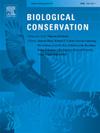UAV-assisted deep learning to support results-based agri-environmental schemes: Facilitating Eco-Scheme 5 implementation in Germany
IF 4.4
1区 环境科学与生态学
Q1 BIODIVERSITY CONSERVATION
引用次数: 0
Abstract
Results-based agri-environmental schemes (AES) hold significant potential to promote biodiversity and ecosystem services within agricultural landscapes. However, a key obstacle to their widespread adoption is the practical challenge of verifying target species (result indicators) accurately and cost-effectively. This study presents a digital and automated approach to verify (result) indicators in grasslands to facilitate the implementation of Eco-Scheme 5, a results-based AES introduced in Germany. The presented approach employs a deep learning-based object detection framework to automatically detect indicator plant species in high-resolution RGB images acquired using unmanned aerial vehicles (UAVs). Additionally, the study explores whether incorporating ground-based imagery into the UAV training dataset could enhance model performance on UAV imagery, hypothesizing robust generalization across these image domains. The Baseline model, trained exclusively on UAV imagery, achieved an average precision (AP50) of 74.0, with performance affected primarily by insufficient training data and class imbalance, particularly affecting species with fewer instances. In contrast, the Enhanced model, trained on UAV imagery enriched with ground-based data, achieved a significantly higher AP50 of 94.2 on the UAV test dataset, demonstrating improved detection accuracy and robust cross-domain generalization. These findings validate the benefits of cross-domain training in improving model performance and emphasize the potential of UAV-integrated artificial intelligence for efficient biodiversity monitoring and supporting the implementation of results-based AES.
无人机辅助深度学习支持基于结果的农业环境计划:促进德国生态计划5的实施
基于结果的农业环境计划(AES)在促进农业景观中的生物多样性和生态系统服务方面具有巨大潜力。然而,广泛采用它们的一个关键障碍是准确和经济有效地核查目标物种(结果指标)的实际挑战。本研究提出了一种数字化和自动化的方法来验证草原的(结果)指标,以促进德国引入的基于结果的AES - Eco-Scheme 5的实施。该方法采用基于深度学习的目标检测框架,在无人机获取的高分辨率RGB图像中自动检测指示植物物种。此外,该研究还探讨了将地面图像纳入无人机训练数据集是否可以提高无人机图像的模型性能,并假设这些图像域的鲁棒泛化。基线模型仅在无人机图像上进行训练,其平均精度(AP50)为74.0,其性能主要受到训练数据不足和类别不平衡的影响,特别是影响较少实例的物种。相比之下,基于地面数据丰富的无人机图像训练的增强模型在无人机测试数据集上获得了更高的AP50(94.2),显示出更高的检测精度和鲁棒的跨域泛化。这些发现验证了跨领域训练在提高模型性能方面的好处,并强调了无人机集成人工智能在高效生物多样性监测和支持基于结果的AES实施方面的潜力。
本文章由计算机程序翻译,如有差异,请以英文原文为准。
求助全文
约1分钟内获得全文
求助全文
来源期刊

Biological Conservation
环境科学-环境科学
CiteScore
10.20
自引率
3.40%
发文量
295
审稿时长
61 days
期刊介绍:
Biological Conservation is an international leading journal in the discipline of conservation biology. The journal publishes articles spanning a diverse range of fields that contribute to the biological, sociological, and economic dimensions of conservation and natural resource management. The primary aim of Biological Conservation is the publication of high-quality papers that advance the science and practice of conservation, or which demonstrate the application of conservation principles for natural resource management and policy. Therefore it will be of interest to a broad international readership.
 求助内容:
求助内容: 应助结果提醒方式:
应助结果提醒方式:


